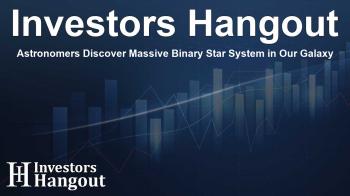Astronomers Discover Massive Binary Star System in Our Galaxy

Astronomers Discover Massive Binary Star System
The binary star system NGC 3603-A1 is renowned for being one of the most massive binaries ever uncovered within our Milky Way Galaxy.
Insights into NGC 3603-A1
A dedicated team of astronomers, led by Dr. Phil Massey from Lowell Observatory, has conducted an unprecedented investigation into NGC 3603-A1. This system showcases two immensely heavy stars whose intricate properties were meticulously measured using both archival data from the Hubble Space Telescope and newly acquired observations. The findings are expected to be published soon in a notable scientific journal.
Creating a Clearer Understanding
Located about 25,000 light-years from our planet, NGC 3603-A1 resides in a vibrant star cluster known as NGC 3603, which is teeming with incredibly hot and luminous stars. The two stars in the NGC 3603-A1 system orbit each other in a rapid cycle of just 3.8 days. To put this into context, within a single year, they complete nearly one hundred orbits around each other.
One of these giants possesses a mass approximately 93 times greater than that of the Sun, while its companion weighs around 70 solar masses. Their extraordinary brightness results in fierce stellar winds and intense radiation, classifying them as a unique type of star called Wolf-Rayet stars. Unlike typical Wolf-Rayet stars, though, the stars in NGC 3603-A1 are in the prime of their youth.
A Breakthrough in Stellar Research
Dr. Massey expressed excitement about this remarkable discovery, indicating that these are some of the heaviest stars ever directly measured in our galaxy, substantially contributing to our understanding of the life cycle of massive stars. Despite previous expectations regarding the mass of NGC 3603-A1, this is the first time these stars' weights have been meticulously quantified.
Collaboration and Discovery
The pivotal progress on this project can be credited to Sarah Bodansky, who was an undergraduate at Carleton College during her research stint at Lowell Observatory amidst the pandemic in 2020. Utilizing the older Hubble data, Bodansky noticed critical features of the stars that had previously gone unnoticed by others.
Her insights revealed a doubling of some spectral features when the stars moved towards and away from observers, a crucial observation for this type of binary system that allowed for a more precise assessment of its mass.
This collaborative effort was powered by a detailed analysis of both new data and archival observations from the Hubble Space Telescope. By observing the stars' orbital dynamics and their light variations, the research team could assess their dimensions, temperatures, and mutual interactions.
Significance of the Discovery
Remarkably, the smaller star in this binary duo appears to have siphoned off material from its larger counterpart, resulting in a faster rotational speed. Such interactions are vital for understanding stellar evolution, including how massive stars might transform or eventually collapse into black holes.
Massive stars like NGC 3603-A1 hold significant importance in the cosmic landscape, particularly concerning gravitational waves—ripples in space-time first identified in 2015. These massive binary systems can evolve into binary black holes, merging to produce gravitational waves, which scientists utilize to explore the universe in innovative ways.
This discovery enhances our comprehension of how stars influence the cosmos, stimulated by the detailed examination of what might have seemed a mere blurry star in a mesmerizing neighborhood of the galaxy.
The Role of Lowell Observatory
The successful unveiling of NGC 3603-A1 also reflects the expertise of a diverse team, which includes Sarah Bodansky alongside several collaborators from recognized institutions. Their combined efforts symbolize the power of collaboration in expanding the frontiers of stellar research.
About Lowell Observatory
Founded in 1894, Lowell Observatory is a notable nonprofit research institution, known for groundbreaking discoveries, such as the expanding universe and the discovery of Pluto. Today, it harnesses global astronomical resources for various investigations within the fields of planetary science and astronomy, drawing around 100,000 visitors each year for educational connections, presentations, and telescope viewing experiences.
Frequently Asked Questions
What is NGC 3603-A1?
NGC 3603-A1 is a binary star system comprising two massive stars, making it one of the heaviest binary systems observed in the Milky Way.
How far is NGC 3603-A1 from Earth?
This binary star system is located approximately 25,000 light-years away from our planet.
Why is this discovery significant?
The discovery enhances our understanding of how massive stars evolve and their role in cosmic phenomena like gravitational waves.
Who conducted the research on NGC 3603-A1?
Dr. Phil Massey and his team at Lowell Observatory led the research on this impressive binary star system.
What are Wolf-Rayet stars?
Wolf-Rayet stars are extremely hot, massive stars nearing the end of their lifecycle, known for their strong stellar winds and bright emissions.
About The Author
Contact Caleb Price privately here. Or send an email with ATTN: Caleb Price as the subject to contact@investorshangout.com.
About Investors Hangout
Investors Hangout is a leading online stock forum for financial discussion and learning, offering a wide range of free tools and resources. It draws in traders of all levels, who exchange market knowledge, investigate trading tactics, and keep an eye on industry developments in real time. Featuring financial articles, stock message boards, quotes, charts, company profiles, and live news updates. Through cooperative learning and a wealth of informational resources, it helps users from novices creating their first portfolios to experts honing their techniques. Join Investors Hangout today: https://investorshangout.com/
The content of this article is based on factual, publicly available information and does not represent legal, financial, or investment advice. Investors Hangout does not offer financial advice, and the author is not a licensed financial advisor. Consult a qualified advisor before making any financial or investment decisions based on this article. This article should not be considered advice to purchase, sell, or hold any securities or other investments. If any of the material provided here is inaccurate, please contact us for corrections.

